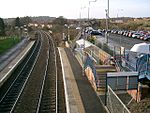Wellwood, Fife
Areas of DunfermlineMining communities in FifeVillages in Fife

Wellwood is a small village to the north of Dunfermline, Fife, Scotland. It was named after the Wellwoods who used to own coalmines in the area. It has a leisure centre and a golf course (Canmore). It is nearby the Town Loch and also is partially bordered by Queen Anne High School. It was formerly known as Hawkiesfauld. Wellwood is an old coal mining village. The coal pits in the village were active throughout the nineteenth century and into twentieth.
Excerpt from the Wikipedia article Wellwood, Fife (License: CC BY-SA 3.0, Authors, Images).Wellwood, Fife
Nightingale Place, Dunfermline Duloch
Geographical coordinates (GPS) Address Phone number Website Nearby Places Show on map
Geographical coordinates (GPS)
| Latitude | Longitude |
|---|---|
| N 56.0625 ° | E -3.4019 ° |
Address
Duloch Schools and Community Campus
Nightingale Place
KY11 8GN Dunfermline, Duloch
Scotland, United Kingdom
Open on Google Maps








